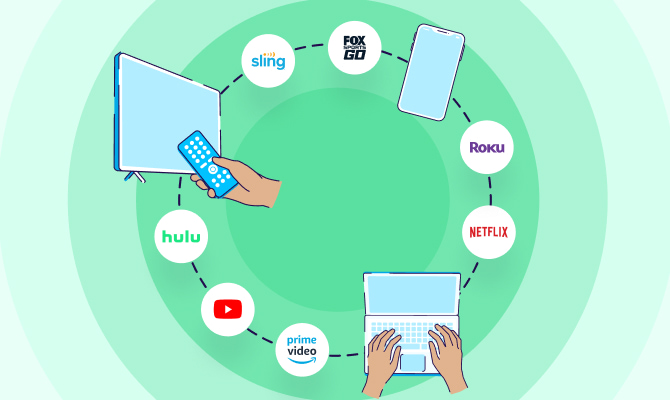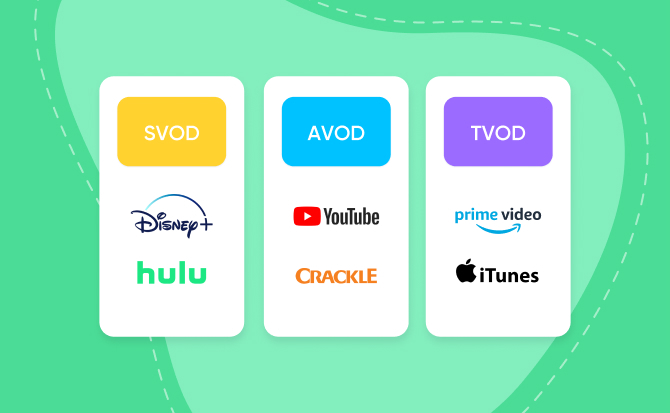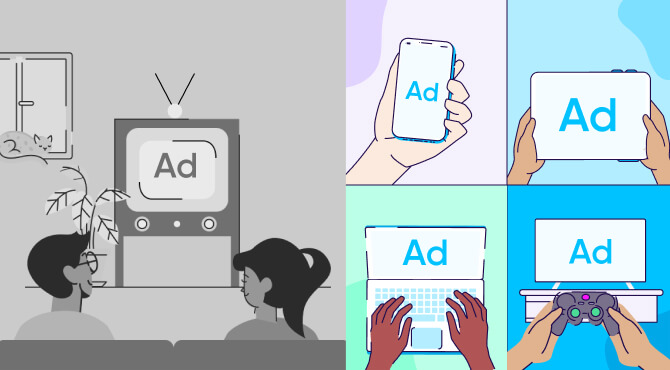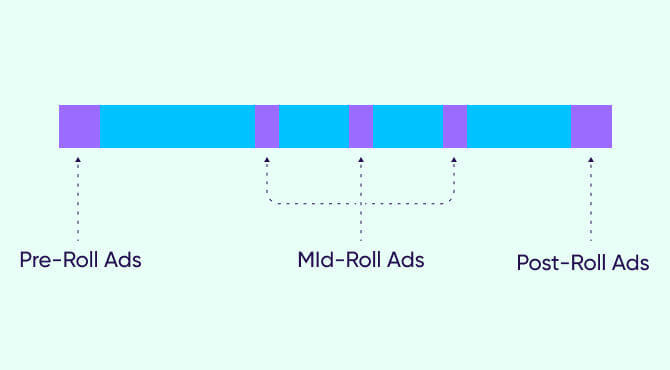What is OTT?
OTT media is content delivered directly over the internet to various devices — TV, desktop, mobile, gaming consoles, and more — bypassing traditional broadcasters, cable, and satellite television platforms.
Try searching for
OTT (over-the-top) is a method of delivering content over the internet, rather than through traditional broadcast TV, satellite, or cable boxes.

OTT content is delivered “over the top” of traditional mechanisms like cable or set-top boxes.
OTT services let users stream content on TV, desktop, mobile, gaming consoles, and tablet devices through dedicated apps and websites. This means viewers can bypass traditional content distributors as they access their favorite programming.
With OTT:
OTT has completely changed the dynamic between media consumers and producers. Whereas traditional distributors would bundle content and play it on a predetermined schedule, OTT cuts out the middleman, giving users direct access to the content of their choice.
As well as offering viewers more choice and control, OTT gives content publishers and marketers a direct connection with their audiences. That represents an incredible opportunity to personalize experiences and develop targeted content production and advertising strategies.
It’s a win-win, as evidenced by the recent surge in OTT revenues. Research shows that worldwide, revenue from OTT TV and video almost doubled between 2019 and 2023 — and it continues to climb steadily, reaching a predicted 215 billion US dollars by 2029.
We can’t talk about OTT without mentioning another, related acronym: CTV. Short for connected TV, CTV refers to the physical devices used to stream OTT content: think Amazon Fire Stick, Apple TV, Roku, or Chromecast, for example, as well as smart TVs and gaming consoles.
OTT, on the other hand, refers to the content and its delivery. So, while the two terms are closely linked, it’s important not to mix them up.

Money makes the world go round – and the world of OTT wouldn’t be possible without effective revenue models to fund it. Here are seven ways publishers (OTT content providers) generate revenue.
The SVOD model relies on regular subscriptions for users to watch whatever they want for a flat monthly price. Offering flexibility for viewers and certainty for publishers, SVOD’s popularity continues to grow.
Popular platforms: Major streaming platforms like Netflix, Disney+, Apple TV+, Amazon Prime Video, Hulu, Max, and Sky all use the SVOD model. Spotify, Apple Music, and Tidal also take this approach for music streaming.
AVOD gives users free access to content in return for watching ads. This advertising generates revenue for the publisher.
Popular platforms: YouTube, DailyMotion, Pluto TV, 4OD, Crackle, Spotify, and Tubi use the AVOD model.
BVOD is a form of video on demand provided by traditional broadcasters. It may be ad supported, like AVOD, or funded in another way.
Popular platforms: NBCUniversal from Peacock is a BVOD service that generates revenue through advertising. Meanwhile, in the UK, BBC iPlayer is funded through the national TV license fee, meaning viewers can watch ad-free.
TVOD operates on a pay-per-view model. Consumers pay for each piece of content they want to watch, or song they want to listen to. TVOD works especially well for sporting events, new film releases, and exclusive content.
Popular platforms: Various broadcasters offer TVOD options for premium events, like sports matches. Other platforms including Netflix, Amazon Prime Video, Sky Box Office, and iTunes also incorporate TVOD, as do learning platforms like Udemy.
As mentioned above, FAST primarily shows linear programming for free. These services are powered by ads and emulate the traditional TV experience, where viewers can’t choose what comes on next.
Popular platforms: Pluto TV is one of the largest FAST services, with others including Roku, Peacock, and Samsung TV Plus.
In a PVOD revenue model, content publishers charge a premium fee for early and exclusive access to video content. The difference between PVOD and TVOD is simply the premium pricing. For example, Disney+ released the movie Mulan for a $30 fee when it first came out, then released it to the rest of the subscriber base after three months.
Popular platforms: Well-known platforms like Netflix, Disney+, Apple TV+, Amazon Prime Video, Hulu, and iTunes use a PVOD model to monetize certain exclusive content.
As the OTT space evolves, providers are experimenting with multiple revenue models. Offering a range of options at different price points enables them to remain competitive and broaden their audience base.
Popular platforms: Major players like Netflix, Hulu, and Disney+ all offer ad-supported tiers on top of a fully paid subscription. Meanwhile, Amazon charges a monthly subscription fee, but also has exclusive content that can be paid for.
Money follows attention — and all the attention right now is on digital content. Here are some of the reasons why everyone’s talking about OTT advertising.
OTT ads play when a single person streams a piece of content. That allows marketers to set niche audience targeting for attributes like interests, location, and demographics.
Compare this to traditional, linear broadcasting, where everyone in the audience sees the same ad as it airs during a program. At best, those traditional ads are targeted at city-sized geographic areas. That’s a lot of people viewing an ad who may have no interest in, or need for, the product.
OTT ads often achieve a video completion rate higher than 90%. Why so high? In part, it’s because many OTT ads aren’t skippable. But even when they are, they’re more relevant to the viewer because of tighter targeting.
Compare this with traditional TV viewing, where more than half of viewers now say they skip every ad.
OTT audiences also tend to be more engaged because they’ve made an active choice to watch this particular content, rather than passively viewing whatever comes on next.
Each person who pulls a piece of OTT content from an app is an audience of one. That allows you to learn more about who sees your ads than when a large mass of people views them at the same time.
Also, many OTT ads are interactive, inviting the viewer to click a link or choose an option. Their interaction gives you an insight into their preferences and can even get them into your marketing funnel for future retargeting campaigns.
Broadcast and cable media providers, on the other hand, can only tell you about the general demographics of the people watching their programs – not individual engagements with your brand.

While tightening privacy restrictions make measurement more challenging for advertisers, OTT advertising allows you to target specific audiences without compromising user anonymity. OTT advertising provides valuable first-party and third-party data to guide accurate placement and timing.
Another reason marketers like OTT advertising is the wide range of ad formats available. Unlike with traditional television, OTT ads can be served differently depending on the content, audience, and campaign goals.
Here’s an overview of the different types to choose from:
Pre-roll ads: Brief ads shown before the video begins.
Mid-roll ads: Ads shown during a video, slotting into natural breaks to maximize user experience.
Post-roll ads: Ads shown at the end of the video.

Picture-in-picture ads: Video ads shown in the corner while the main video is playing.
Interactive ads: Ads that ask viewers to engage with them via a link, survey, or mini game.
Companion banner ads: Banner ads that show alongside the main video content.
Out-stream video ads: Video ads that appear outside of the main video, including in-article, in-feed, or in-banner.
In the near future, we’ll see more people with more devices using faster internet connections. Virtually every aspect of OTT shows signs of continued growth for years to come. Here’s why:
In short, more people are consuming OTT media.
With 5G technology slowly rolling out in every major city around the world, along with internet companies like Starlink, the growing internet infrastructure allows more people to enjoy high-quality content through their personal devices, whenever they want. Faster download speeds will not only deliver content to more people, but will continuously improve user experience.
An estimated 3.3 billion people will view an OTT video in 2025. The Asia-Pacific region in particular is projected to grow to 1.345 billion users in 2026.
Marketers are making bigger bets on OTT media while their investment in traditional channels stays flat. Spending on OTT video ads will almost double in the US from 2020 ($34 billion) to 2025 ($63 billion).
Podcast ad spending is headed in the same direction, estimated to surpass $2.5 billion by 2025. Broadcast TV ad revenue is predicted to remain stagnant at around $65 billion for the foreseeable future.
With more dollars pouring into the OTT pool, competition will get tighter and costs could rise — a signal to invest in OTT ads sooner rather than later.
Hulu+ may have started the trend with its robust self-service ad platform, but a number of other players have since jumped on the ad-supported bandwagon, including Netflix and Disney+.
Hybrid monetization strategies help publishers win new customers in a competitive market, even as household budgets are being squeezed by the ongoing cost-of-living crisis. And making advertising platforms more accessible is a great way to attract advertisers.
While mobile devices offer a popular way to watch OTT content on the go, more of us are investing in smart TVs for the home. That gives advertisers the opportunity to create big-screen commercials with impact.
As OTT platforms become more accessible, increasing numbers of niche content providers are developing their own services. Whether it’s businesses creating content for their customers, or specialist platforms like Crunchyroll (anime), Kweli (focused on the Black community), or NextUp (comedy), this approach opens the door to laser-sharp ad targeting.
AppsFlyer’s CTV measurement and analytics platform gives you the insights you need to make the most of the golden OTT opportunity. Leading players in the OTT and CTV market trust us to measure every aspect of their campaigns, across platforms and devices, and turn that in-depth data into clear, actionable insight to drive growth and engagement.
OTT media is content delivered directly over the internet to various devices — TV, desktop, mobile, gaming consoles, and more — bypassing traditional broadcasters, cable, and satellite television platforms.
OTT refers to the content and the way it’s delivered (“over the top” of traditional media). CTV stands for connected TV and refers to the physical devices used to stream OTT content — things like smart TVs, gaming consoles, or items like Amazon Fire Stick and Chromecast.
OTT platforms need to keep producing fresh content to win and retain users. To do that, they generate revenue through several models, including subscription video on demand (SVOD), advertising-based video on demand (AVOD), transactional video on demand (TVOD), free ad-supported television (FAST), premium video on demand (PVOD), and hybrid strategies that combine these revenue streams.
OTT advertising involves placing targeted video ads on streaming platforms, to reach viewers on devices like smart TVs and smartphones with enhanced precision and flexibility.
OTT advertising offers a variety of formats such as pre-roll, mid-roll, and post-roll ads, along with innovative options like picture-in-picture, interactive ads, companion banner ads, and out-stream video ads, allowing for a tailored viewing experience.
OTT advertising stands out for its precision targeting, high viewer engagement, and robust analytics. Unlike traditional TV ads, OTT ads can target specific demographics with high video completion rates, offering insights into viewer preferences and behaviors without compromising user privacy.